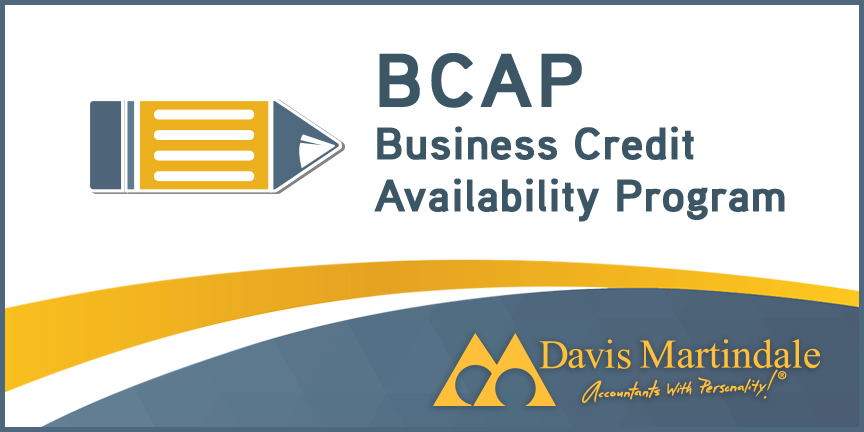The Government of Canada, through the Business Development Bank of Canada and Export Development Canada, and in partnership with the various financial institutions, has introduced the Business Credit Availability Program (BCAP). The purpose of BCAP is to help businesses obtain financing during the current period of uncertainty and hardship due to COVID-19.
An overview of the various BCAP programs can be found on the Government of Canada website: https://www.canada.ca/en/department-finance/programs/financial-sector-policy/business-credit-availability-program.html
Businesses are directed to contact their current financial institution for program information and in order to apply. With the exception of the $40,000 Canada Emergency Business Account (CEBA), BCAP program applications will generally require businesses to provide the lender some or all of the following information:
- Your most recent accountant prepared financial statements, and your most recent internally prepared financial statements.
- A recent list of your accounts receivable and accounts payable.
- A forecast or projection model. At a minimum, this should be your expected cash flows over the next 6 to12 months, along with a business plan.
Most businesses can readily provide the items in the first two categories.
The items in the third category, a cash flow forecast and business plan, may be less familiar to some business owners.
Cash Flow Forecast
The cash flow forecast is important for lenders as it shows the business’ expected shortfall in funding – by month – for the next 6 to 12 months as a result of Covid-19. In addition to quantifying your funding needs, it demonstrates to your lender that you have put significant thought and effort into developing a strategy to cope with, and manage, the lack of revenue and other short term impacts of Covid-19.
The cash flow projection will be expected to show the monthly impact on two main parts of the business:
Cash receipts
You will need to map out, by month, the cash you anticipate receiving from sales and the collection of receivables. What adjustments need to be made due to lost or deferred sales, or customers’ financial hardship? For example, what is the impact of a partial or complete suspension of your operations, the interrupted operations of your suppliers or customers, or a general decline in customer demand? Will these sales be recaptured in the future?
Cash expenditures
These should also be reported on a monthly basis, and can be further broken down between non-discretionary and discretionary:
- Non-discretionary – What cash outlays must continue? Common items are utilities, rent, property taxes, insurance, interest, and other fixed costs on your income statement. Be sure to also include the principal portion of required loan repayments. (Also, consider asking our financial institution if they can reduce or remove the principal portion of your loan repayments for a few months).
- Discretionary – What expense items vary depending on sales and other activities, or can otherwise be reduced or eliminated? Consider advertising, mileage, travel and certain supplies. This is an opportunity to scrutinize your spending to determine what is and isn’t necessary – both during a time of crisis, and perhaps even when things return to normal.Salary and wages may be split between non-discretionary and discretionary, and will be affected by variable wages, reduced hours, lay offs, etc. Be sure to also reflect the benefit of COVID-19 wage subsidies, being mindful of the relevant timing: the Temporary Wage Subsidy will typically reduce payroll tax remittances in the following month, and the CRA has indicated that the Canada Emergency Wage Subsidy (CEWS) will be received approximately 6 weeks after application is made.
Don’t forget to include payroll remittances, HST payments or refunds, and income tax payments or refunds in your cash flow projection. Keep in mind that due dates for instalments and payments of income tax and HST may be deferred under the Government’s COVID-19 tax relief measures.
For both cash receipts and cash expenditures, ensure all of your numbers are supportable. Estimates are acceptable provided they are accompanied by solid research and analysis. Be ready to provide your lease agreement, payroll forms, etc.
Expenditures net of revenue will show your monthly cash shortfall. The total of these for the next 6 to 12 months will help you estimate the funding you will require to keep your business operating until the environment returns to normal.
Business Plan
Preparing your cash flow projection will help you draft your business plan. This document should layout your strategy to get through this period, and prepare you for the time afterward. Your business plan should include:
- A request for the financing amount determined by your cash flow forecast. Where possible, identify which BCAP program you believe best fits your needs.
- Details on the business’ existing funding and financing availability, other possible sources of funds (sale of redundant business assets, personal loans), and disclose any other lenders and the support they might also provide.
- A summary of human resources and payroll information: your pay period, current number of employees, details of wage reductions and lay offs, and the expected amount and timing of COVID-19 wage subsidies.
- A description of the steps you have already taken, and the steps you plan to take, to mitigate your cash shortfall. For example, contacting suppliers and customers in order to manage their expectations and requirements, and yours.
- An explanation of the business’ current operating level, and how you expect it to trend over the course of the COVID-19 crisis.
- A discussion of the unique things you are doing to both cope currently, and prepare for success when things come back to some semblance of normalcy.
- Your thoughts on whether your business will go back to normal and when: Will you return to 50%, 75% or 100%, and when? Will your business experience a “new” normal?
Armed with the above documents, analysis and information, your financial institution will be able to more quickly process and return your BCAP financing application.

